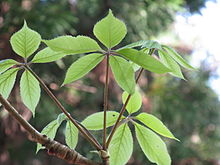| Chengiopanax sciadophylloides | |
|---|---|

| |
| Scientific classification | |
| Kingdom: | Plantae |
| Clade: | Tracheophytes |
| Clade: | Angiosperms |
| Clade: | Eudicots |
| Clade: | Asterids |
| Order: | Apiales |
| Family: | Araliaceae |
| Genus: | Chengiopanax |
| Species: | C. sciadophylloides |
| Binomial name | |
| Chengiopanax sciadophylloides (Franch. & Sav.) C.B.Shang & J.Y.Huang | |
| Synonyms | |
| Synonymy | |
Chengiopanax sciadophylloides is a flowering tree in the family Araliaceae native to Japan. Previously included in the genus Eleutherococcus, it is distinguished from other members of that genus by not having spines or prickles and ITS sequence data confirmed the separation.
Chemistry
Chengiopanax sciadophylloides has been found to be a specific hyperaccumulator of manganese even in soils not contaminated with excessive amounts of manganese. In wild plants manganese concentrations of up to 23 grams per kilogram (0.37 oz/lb) of dried leaf have been analyzed.
After the Fukushima Daiichi nuclear disaster in March 2011 it was found that Chengiopanax sciadophylloides accumulated the radioactive isotope Caesium-137 to concentrations above the human consumption guideline of 100 becquerels per kilogram of fresh weight even as far away as Nagano and Iwate Prefectures. Analysis of leaves taken from Chengiopanax sciadophylloides in August and October 2013 from a forest 37 kilometres (23 mi) northwest of the Fukushima Dai-ichi Nuclear Power Plant found a mean concentration of 28,100 becquerels per kilogram of dry weight, over three times those of other trees. They also accumulated the non-radioactive Caesium-133 more than other trees.
Uses
Known as koshiabura (コシアブラ), gonzetsu and gonzetsunoki in Japanese cuisine, it is foraged in the wild in spring for the young leaves as sansai ("mountain vegetables"). Called the "queen of sansai". Often used in tempura but popular in a range of dishes. The highest grade of buds is as small as a calligraphy brush and so named fude ha ("leaf of brush").
A decoction of the roots, tea of the root bark, and tea of the leaf were used in the Niigata Prefecture as a folk remedy.
A lacquer-like coating material called kinshitsu (金漆) used to be made from the sap. The polyacetylenes in the plant sap were polymerised by sunlight to produce the hard resin varnish. Two other members of the Araliaceae, Dendropanax trifidus and Gamblea innovans, may also have been sources for this lacquer in Japan. The lacquer was used to prevent corrosion of suits of armour and helmets, with related species providing a similar lacquer used in China during the Tang dynasty and in Korea.
The wood is used for general construction and for chopsticks. The wood is regarded as auspicious and is valued in the Sasano-Bori doll carving tradition in Yonezawa (along with the wood of the Pagoda Tree) for its strength and flexibility.
References
- The Plant List, Chengiopanax sciadophylloides (Franch. & Sav.) C.B.Shang & J.Y.Huang
- Yunfei, Deng (2003). "Eleutherococcus humillimus, a New Combination in Chinese Araliaceae". Novon. 13: 305–306. doi:10.2307/3393262. Retrieved 27 May 2017.
- Mizuno, Takafumi; Emori, Kanae; Ito, Shin-ichiro (2013). "Manganese hyperaccumulation from non-contaminated soil in Chengiopanax sciadophylloides Franch. et Sav. and its correlation with calcium accumulation". Soil Science and Plant Nutrition. 59 (4): 591–602. doi:10.1080/00380768.2013.807213.
- ^ Sugiura, Yuki; Kanasashi, Tsutomu; Ogata, Yoshimune; Ozawa, Hajime; Takenaka, Chisato (2016). "Radiocesium accumulation properties of Chengiopanax sciadophylloides". Journal of Environmental Radioactivity. 151 (1): 250–7. doi:10.1016/j.jenvrad.2015.10.021. PMID 26536624. Retrieved 27 May 2017.
- ^ *MAFF (Dec 2004). "山菜関係資料(Sansai-related material)" (PDF). Ministry of Agriculture. Archived from the original (PDF) on April 20, 2012. Retrieved September 11, 2016. (government website PDF)
- ^ Brussell, David Eric (2004). "Araliaceae species used for culinary and medicinal purposes in Niigata-ken, Japan". Economic Botany. 58 (4): 736–739. doi:10.1663/0013-0001(2004)058[0736:ASUFCA]2.0.CO;2. JSTOR 4256887.
- "Koshiabura". Specialty Produce. Retrieved 27 May 2017.
- NAGY 植物図鑑. コシアブラ (in Japanese). Archived from the original on July 26, 2009. Retrieved August 23, 2009.
- Terada, Akira; Tanoue, Yasuhiro; Kishimoto, Daishiro (1989). "(−)-(9Z)-1,9-Heptadecadiene-4,6-diyn-3-ol as a Principal Component of the Resinous Sap of Evodiopanax innovans Nakai, Japanese Name, Takanotsume, and Its Role in an Ancient Golden Varnish of Japan". Bulletin of the Chemical Society of Japan. 62 (9): 2977–2980. doi:10.1246/bcsj.62.2977.
- "Wooden Carving". Takumi Traditional Japanese Dolls & Gifts. TLT Co. Ltd. Retrieved 28 May 2017.
- [REDACTED] Media related to Chengiopanax sciadophylloides at Wikimedia Commons
| Taxon identifiers | |
|---|---|
| Chengiopanax sciadophylloides |
|
| Acanthopanax sciadophylloides | |
じゃじゃじゃじゃ
Categories: